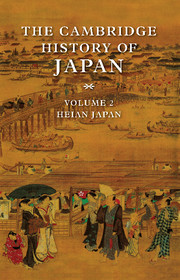Book contents
- Frontmatter
- Introduction
- 1 The Heian court, 794–1070
- 2 The capital and its society
- 3 Land and society
- 4 Provincial administration and land tenure in early Heian
- 5 Chinese learning and intellectual life
- 6 Aristocratic culture
- 7 Aristocratic Buddhism
- 8 Religious practices
- 9 Insei
- 10 The rise of the warriors
- Works cited
- Glossary-index
- Japan in the Heian period"
- References
5 - Chinese learning and intellectual life
Published online by Cambridge University Press: 28 March 2008
- Frontmatter
- Introduction
- 1 The Heian court, 794–1070
- 2 The capital and its society
- 3 Land and society
- 4 Provincial administration and land tenure in early Heian
- 5 Chinese learning and intellectual life
- 6 Aristocratic culture
- 7 Aristocratic Buddhism
- 8 Religious practices
- 9 Insei
- 10 The rise of the warriors
- Works cited
- Glossary-index
- Japan in the Heian period"
- References
Summary
INTRODUCTION AND ASSIMILATION OF CHINESE LEARNING
The subject of this chapter is the learning of the Heian upper class – not all of it, by any means, but that portion of it which was regarded as fundamental in the education of males and which, even in times of decline, enjoyed the highest formal prestige. “Chinese learning,” for our purposes, can be defined as the reading and writing of Chinese and those kinds of knowledge most directly dependent on learned traditions which boasted Chinese roots. Our focus will be on government, Confucian study, and belles lettres – overlapping categories in the Heian context. We will touch on those aspects of law mostly directly related to Chinese learning and its exponents, but we will largely leave aside some other forms of Chinese knowledge such as medicine, various kinds of divination, the calendar, and explication of the sutras. Mathematics, though important to the practice of government and included among the curricula of the state Academy (Daigaku-ryō), ceased to prosper as a field of study very early in the period. We will leave aside also the important topic of the influence of Chinese learning on such native forms of literature as waka and monogatari, and on painting, music, and dance.
A view that is fortunately losing currency among Western students of Japan holds that to the Japanese the Chinese language remained permanently alien: if Heian males failed to produce masterpieces of imaginative prose paralleling those of their womenfolk, it was owing to the burden of having to compose in a medium in which they were ill at ease; and if, for example, a Japanese literatus chose to write of Taoist immortals in the belief that such beings also existed in his own land, he must have been playing with “exotic” ideas.
- Type
- Chapter
- Information
- The Cambridge History of Japan , pp. 341 - 389Publisher: Cambridge University PressPrint publication year: 1999
References
- 1
- Cited by



